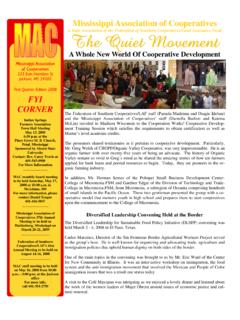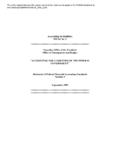Transcription of African American farmers - Federation of Southern ...
1 African American farmers and civil rights.(Pigford v. Glickman). Journal of Southern History - February 1, 2007. Pete Daniel Word count: 15329. citation details FORTY ACRES AND A MULE." JUDGE PAUL L. FRIEDMAN BEGAN HIS 1999 decision in Pigford v. Glickman, the successful class-action suit brought by African American farmers , with that familiar broken promise from the Civil War/Reconstruction era. The case concerned the sorry civil rights record of the Department of Agriculture ( usda ) and its denial of federal benefits to black farmers in the years after World War II and in particular the thirty-five years since the Civil Rights Act of 1964. The decline of black farmers alter World War II contrasted dismally with their gains in the half century after emancipation when, demonstrating tremendous energy and sagacity, they negotiated a maze of racist law and custom and--during the harshest years of segregation, peonage, and violence- -gained land and standing in Southern communities.
2 By 1910 African Americans held title to some sixteen million acres of farmland; by 1920 there were 925,000 black farms in the country. In the teens and twenties, however, the graph of rising ownership faltered and then plunged downward. Depression, mechanization, and discriminatory federal programs devoured black farmers , but their fate was eclipsed by press coverage of school segregation, voting rights, and public accommodations. They almost disappeared without a trace. (1). Racism circulated through federal, state, and county usda offices, and employees at every level bent civil rights laws and subverted government programs in order to punish black farmers . Judge Friedman admitted that the Pigford case would "not undo all that has been done" but insisted it was "a good first step." By 2000, of course, it was too late for hundreds of thousands of black farmers . When Judge Friedman handed down his decision only months before the end of the millennium, there were but eighteen thousand black farms left, and many of those were endangered.
3 Underlying Friedman's decision was a disturbing contradiction: black farmers suffered their most debilitating discrimination during the civil rights era when laws supposedly protected them from racist policies. While white farmers also lost land, black farmers endured not only similar economic forces but also usda racism. The increase in usda programs had an inverse relationship to the number of farmers : the larger the department, the more programs it generated, and the more money it spent, the fewer farmers who survived. (2). For a century and a third, the Department of Agriculture presided over monumental changes in the countryside. Since its founding during the Civil War, the usda has encouraged better farming methods, and over time its staff has swelled and its reach has extended to every crossroads and farm. Early in the twentieth century the Extension Service became a conduit for feeding farmers advice on the latest science and technology from experiment stations and corporations.
4 Some farmers welcomed and utilized research findings, but others were skeptical of experts and outsiders. The usda and its supporters denigrated farmers who did not accept the gospel of progress. Yet the substitution of science and technology for human experience and expertise deskilled farmers who relied increasingly upon formulaic methodology rather than husbandry. Knowledge handed down or gained by trial and error laded away. The human cost that accompanied the rise of agribusiness was eclipsed by the story of tractors and picking machines, insecticides and herbicides, and hybrids and genetically engineered crops. (3). The term agribusiness came into vogue during the World War II era and in its broadest context refers to the farms, firms, and lobbying groups that thrive on the production, processing, storing, shipping, and marketing of food and fiber. Agribusiness's counterpart in the public sector, agrigovernment, 1. often worked from a similar agenda and included the usda 's headquarters bureaucracy, complex of experiment stations, research facilities, regulation units, and acreage policy divisions; the land-grant universities; state agricultural offices; and county agricultural employees and committees.
5 Agribusiness and agrigovernment cooperated--conspired, some might argue--to replace labor- intensive with capital-intensive farming operations. Federal agricultural policy and laborsaving science and technology became tools that ruthlessly eliminated sharecroppers, tenants, and small farmers . The human dislocation caused by this transformation was masked by an upbeat and sterile bureaucratic vocabulary of progress that eroded, even insulted, the more prosaic language of farmers and by rules and regulations that changed annually and that unnecessarily complicated farm life. (4). President Franklin D. Roosevelt's New Deal agricultural policies greatly expanded the reach and power of the usda . While some programs aided poorer farmers during the 1930s, by World War II. conservative farmers and interest groups eroded such initiatives. Increasingly, powerful farmers and pliant bureaucrats operated the machinery that disbursed federal funds and information. The farmers Home Administration (FHA, later FmHA), the lender of last resort, disbursed credit, but not necessarily to the most needy.
6 The Agricultural Stabilization and Conservation Service (ASCS). awarded acreage allotments (acreage ASCS committees assigned to farms based on their historical production), heard appeals, supervised conservation programs, and even approved some categories of loans. The segregated Federal Extension Service (FES) provided the latest information on relevant science and technology, organized and supervised 4-H clubs for youth, taught better farming techniques, and offered household advice through demonstration clubs for women. The county committees of these three powerful pseudo-democratic committees hired extension and home demonstration agents, controlled information, adjusted acreage allotments, disbursed loans, adjudicated disputes, and, in many cases, looked after family and friends. Through the FES, land- grant universities, and experiment stations, county elites drew on science and technology and became collusive partners of agrigovernment. African Americans had no voice in usda decisions, nor did many poor whites.
7 Prior to 1964 no African American served on a county committee, and whites hoped to keep it that way. (5). On April 22, 1965, Secretary of Agriculture Orville L. Freeman issued a memorandum demanding that the usda staff "put into effect with dispatch" comprehensive policies that would ensure an end to discrimination. "The right of all of our citizens to participate with equal opportunity in both the administration and benefits of all programs of this Department is not only legally required but morally right," he insisted. Despite Secretary Freeman's ringing words, black farmers lost ground in the 1960s, primarily because of Freeman's failure to control vindictive white bureaucrats but in part because the press spotlighted voting rights, school integration, and major demonstrations while the discriminatory treatment of black farmers remained in the shadows. (6). Civil rights laws theoretically offered the promise of equal rights that would give African Americans parity with whites in obtaining allotments, credit, information, and access to government largesse.
8 Over the years, however, whites had amassed enormous resources and built strong defenses. It was as if agribusiness accelerated around a supercollider track gaining speed and bulking up on machines, chemicals, research, government subsidies, and racial prejudice, and when it collided with the stalled civil rights target, it blew apart African American aspirations for rural life and created new elements that reshaped the countryside. Historians are still attempting to discover what was created and what was destroyed in that impact. In the century-and-a-half continuum of usda racism, an opportunity appeared in the mid-1960s that could have moved the department toward equal rights. In 1965 Secretary Freeman appointed African American William M. Seabron as assistant to the secretary for civil rights and established a citizens'. advisory committee on discrimination. The Commission on Civil Rights, an independent agency 2. created by the Civil Rights Act of 1957 to investigate and report on a broad spectrum of discriminatory practices, focused on usda programs and in 1965 released a highly critical study, Equal Opportunity in Farm Programs, revealing how the ASCS, the FHA, and the Federal Extension Service bitterly resisted demands to share power with African Americans.
9 The commission also cooperated with the Sharecroppers Fund and the National Association for the Advancement of Colored People (NAACP), sharing complaints and suggesting approaches to end discrimination. These initiatives challenged white hegemony and provoked usda racists at the county, state, and federal levels first to resist implementing civil rights and ultimately to drive black farmers from the land. The tracks of racism and discrimination led from local committees and agriculture offices to state offices, to land-grant schools, to experiment stations, and on to Washington to disappear into the trackless bureaucratic wilderness where untamed racism flourished, where men and women alienated from the land punished the clientele they were hired to help. (7). Confronting such dedicated racists presented a challenge to William Seabron, who coordinated the equal rights policies of twenty usda agencies. A native of Chicago, Seabron had graduated from the University of Iowa with a degree in chemistry and also attended DePaul University and the University of Michigan.
10 From 1945 until he arrived in Washington in 1962, he had worked for the Urban League and the Michigan Fair Employment Practices Commission. In the aftermath of the report by the Commission on Civil Rights, Seabron attempted to implement Secretary Freeman's edicts. His agenda seemed bold--integration of the Federal Extension Service, appointment of blacks to several state ASCS committees, temporary jobs for blacks in ASCS offices, and the prediction that by July 15, 1965, the farmers Home Administration would have biracial committees in all states where a significant number of black farmers resided. (8). William Seabron had good intentions but little power to carry them out. He could seek compliance with civil rights laws and hold hearings, but only the secretary of agriculture could implement and enforce policy. Seabron attempted to curb racist policies of the Federal Extension Service but was frustrated at every turn. According to a 1968 study by the Commission on Civil Rights, Seabron's staff "cited occasions when their requests for action by an agency have been ignored altogether.









